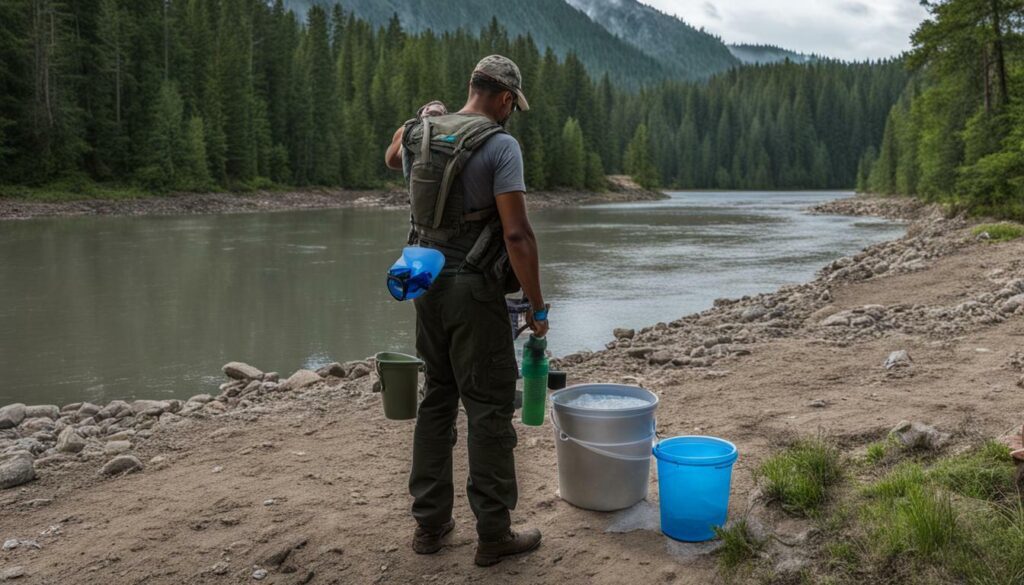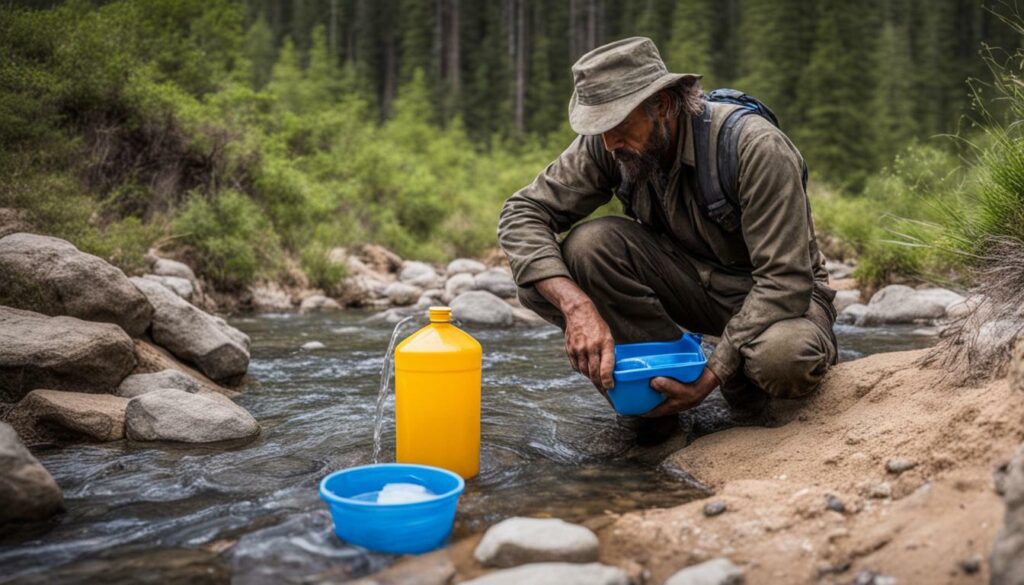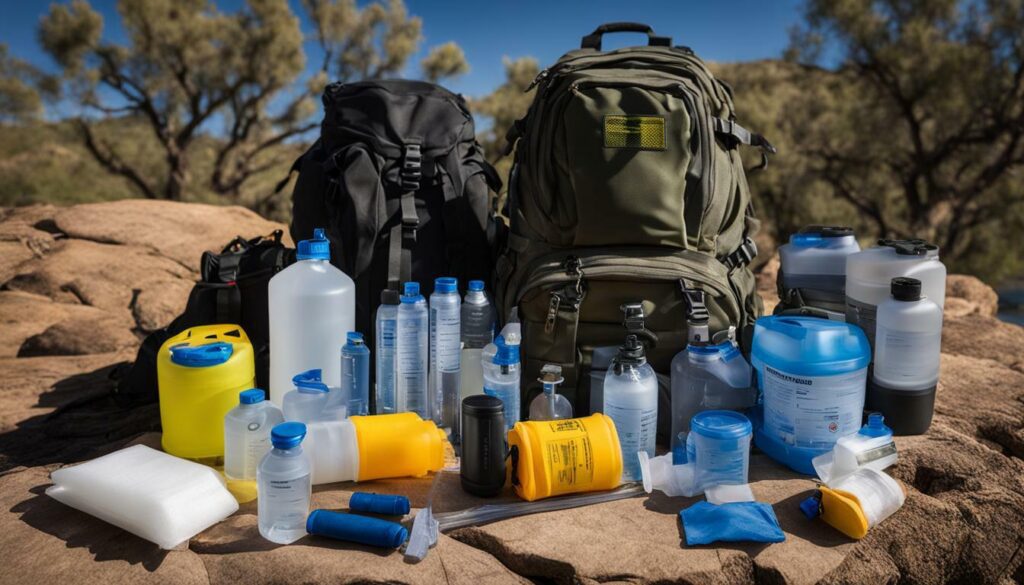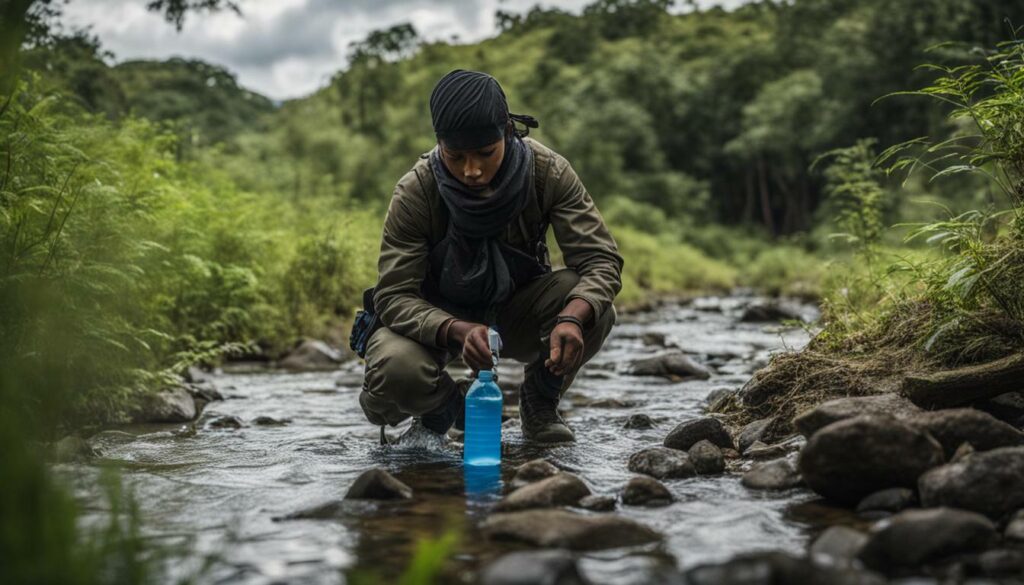
Welcome to the essential guide to prepper water purification techniques. In this comprehensive article, I will share vital information to help you equip yourself for survival with safe, clean drinking water methods.
Key Takeaways:
- Water is the most important supply to stock up on in preparation for an emergency.
- Proper water storage includes using large, food-grade, non-translucent containers stored in a cool, dark, dry place.
- Alternative water sources such as rivers, lakes, and rainwater can be collected and filtered for safe consumption.
- Portable water storage containers are essential for extended survival scenarios.
- Purification methods include boiling, chemical treatment, solar pasteurization, distillation, and mechanical filtration.
By following the guidelines in this guide, you can ensure a sufficient supply of safe water for yourself and your loved ones during emergency situations. Let’s dive into the details of prepper water purification techniques and equip ourselves for any challenge that may arise.
The Basics of Water Storage for Preppers
Before diving into the various water purification techniques, it’s essential to understand the basics of water storage for preppers. Properly storing water is crucial for maintaining a long-lasting, reliable water supply.
When it comes to water storage, selecting the right containers is key. Look for large, food-grade containers that are durable and made of non-translucent materials. This is important to prevent sunlight from promoting the growth of algae and other harmful bacteria.
| Container Type | Capacity | Pros | Cons |
|---|---|---|---|
| Food-grade plastic containers | 5 gallons to 55 gallons | Durable, lightweight, stackable | May degrade over time |
| Stainless steel barrels | 30 gallons to 55 gallons | Sturdy, resistant to corrosion | Heavier and more expensive |
| Water bricks | 3.5 gallons per brick | Easy to transport, stackable | Requires more space |
It’s also important to store water in a cool, dark, and dry place to prevent contamination. Avoid storing water near chemicals, gasoline, or other substances that could contaminate the water supply.
Additionally, it’s a good idea to have water filters or portable stoves on-hand for long-term storage. These can be used to purify water in case the stored supply runs out or becomes contaminated. Having a backup plan for water purification is essential for preppers.
Remember, when it comes to water storage, it’s better to be overprepared than underprepared. By following these basics of water storage for preppers, you can ensure a reliable water supply in emergency situations.
Alternative Water Sources for Survival Situations
In emergency situations, access to clean water may be limited, making alternative water sources a vital resource for survival. This section will explore various methods for finding, collecting, and treating water from sources found in the wild.
Finding Water: When searching for water in the wild, it’s important to look for natural features such as rivers, lakes, and streams. These bodies of water are often the easiest to locate and can provide a substantial amount of water for purification. Additionally, keep an eye out for signs of vegetation, as plants like cacti and bamboo can indicate the presence of underground water sources.
Collecting Water: Once you have found a water source, it’s crucial to collect and store the water properly. Use a clean container, preferably made of food-grade material, to minimize the risk of contamination. A wide-mouth container makes filling and pouring easier. It’s advisable to filter the water through a cloth or t-shirt to remove any debris or sediments before storing it.
Treating Water: Before consuming water from alternative sources, it’s vital to treat and purify it to ensure it is safe for consumption. There are several methods you can use for water purification in survival situations. Boiling the water is one of the simplest and most effective methods. Alternatively, you can use chemical treatments like water purification tablets or liquid chlorine. If sunlight is available, solar distillation or pasteurization can also be used to kill harmful bacteria and viruses. It’s crucial to follow the instructions provided with each method to ensure the water is purified effectively.
As John Muir once said, “The rivers flow not past, but through us.” In survival situations, it’s essential to remember that water is a precious resource that connects us with nature and sustains our lives. By understanding how to find, collect, and treat water from alternative sources, preppers can ensure a safe and reliable water supply when faced with emergencies.
Remember, in times of crisis, knowledge and preparation are key. By expanding your understanding of alternative water sources and learning how to properly collect and purify water, you can enhance your chances of survival. Utilize the techniques and methods discussed in this section to ensure you have access to clean and safe water when it matters most.
When preparing for prolonged survival scenarios, it’s crucial to have portable water storage containers that can withstand the rigors of a prepper’s journey. This section will introduce you to some top recommendations.
| Container | Features | Capacity |
|---|---|---|
| 1. WaterBrick | Durable, stackable, and BPA-free | 3.5 gallons |
| 2. Reliance Products Aqua-Tainer | Spigot for easy dispensing and hideaway handle | 7 gallons |
| 3. Scepter BPA Durable Water Container | Impact-resistant and built-in handle | 5 gallons |
These portable water storage containers are designed to meet the needs of preppers on the move. The WaterBrick, with its stackable design, allows for easy transport and storage, making it an excellent choice for those who may need to relocate frequently. The Reliance Products Aqua-Tainer features a convenient spigot for easy access to water, while the Scepter BPA Durable Water Container offers durability and a built-in handle for effortless carrying.
Remember, when selecting a portable water storage container, always opt for food-grade, non-translucent containers to prevent contamination. It’s also important to regularly check and replace seals to maintain the integrity of the containers.
Having reliable portable water storage containers is essential for any prepper’s emergency preparedness plan. They provide a convenient and secure way to store and transport water during extended survival situations. By investing in durable containers like the WaterBrick, Reliance Products Aqua-Tainer, or Scepter BPA Durable Water Container, preppers can ensure a safe and sufficient water supply no matter where their journey takes them.
Boiling: A Reliable Method for Water Purification
Boiling water is one of the oldest and most reliable methods for purifying water in emergency situations. In this section, we will explore this effective technique and discuss the necessary steps for successful water purification.
To properly purify water through boiling, you will need a heat source, a pot or kettle, and access to clean water. Begin by filling the pot with the available water, ensuring it is free from debris or visible impurities. Place the pot on the heat source and bring the water to a rolling boil.
For proper water purification, it is recommended to maintain a rolling boil for at least one minute. However, in higher elevations where the boiling point is lower, the water should be boiled for longer, typically three minutes. This ensures that any harmful bacteria, viruses, or parasites present in the water are effectively killed.
Once the water has been thoroughly boiled, remove it from the heat source and let it cool before use. It is important to note that boiling water only kills microorganisms but does not remove chemical contaminants or heavy metals. If you suspect chemical contamination, it is recommended to use additional water purification methods such as chemical treatment or filtration.
In conclusion, boiling water is a reliable and accessible method for purifying water in emergency situations. By following the necessary steps and maintaining a rolling boil for the appropriate amount of time, you can ensure the safety of your water supply. Remember to always prioritize water storage and have the necessary equipment and knowledge to purify water for your prepper needs.
Chemical Treatment for Water Purification
Chemical treatment is another effective approach for purifying water when access to heat or mechanical filtration is not possible. In this section, we will explore chemical treatment methods that can ensure safe drinking water during emergencies.
One commonly used chemical for water purification is iodine. Iodine tablets or liquid can be added to water to kill harmful bacteria, viruses, and parasites. The recommended dosage is typically one or two drops of iodine per liter of water, depending on water clarity and temperature. After adding the iodine, it is important to let the water sit for at least 30 minutes before consuming. It is worth noting that iodine treatment may not be suitable for pregnant women, individuals with thyroid conditions, or those with allergies to iodine.
Chlorine is another widely available chemical for water disinfection. You can use household bleach that contains 5.25% to 6% sodium hypochlorite to purify water. The general guideline is to add eight drops of bleach per gallon of water, or half a teaspoon for every five gallons. After adding the bleach, stir the water and let it sit for at least 30 minutes. The water should have a slight chlorine smell. If there is no smell, repeat the dosage and wait an additional 15 minutes. It is important to use unscented bleach without any additives or additional cleaning agents.
| Chemical | Dosage |
|---|---|
| Iodine | 1-2 drops per liter |
| Chlorine | 8 drops per gallon |
| Household bleach | 1/2 teaspoon per 5 gallons |
It is important to note that while chemical treatment can effectively kill most pathogens, it may not remove certain chemical contaminants or heavy metals from the water. Therefore, it is advisable to use chemical treatment methods in conjunction with other water filtration techniques for comprehensive purification.
In summary, chemical treatment provides an accessible and reliable method for purifying water in emergency situations where boiling or mechanical filtration may not be feasible. By using iodine or chlorine, you can disinfect water and make it safe for consumption. Remember to follow the recommended dosages, allow sufficient contact time, and always prioritize the safety of your water supply in preparation for any unexpected events.
Solar Pasteurization and Distillation Methods
When traditional methods are not available, solar pasteurization and distillation offer innovative solutions for purifying water using the power of the sun. In this section, we will delve into these methods and explore their benefits for survival water treatment.
Solar pasteurization is a simple and effective method that utilizes the sun’s heat to kill pathogens in water. The process involves filling clear plastic or glass containers with water and placing them in direct sunlight for about 6 hours. The heat from the sun raises the temperature of the water, effectively killing harmful bacteria and viruses. It is important to note that this method may not eliminate certain chemical contaminants, so it is advisable to use it in conjunction with other filtration methods.
Distillation, on the other hand, is a more complex process that involves collecting the evaporated water and condensing it back into a liquid form. The heat from the sun causes the water to evaporate, leaving behind contaminants and impurities. The evaporated water then condenses on a cooler surface and is collected as purified water. Distillation can effectively remove bacteria, viruses, heavy metals, and other contaminants, making it a reliable method for survival water treatment.
| Method | Benefits |
|---|---|
| Solar Pasteurization | – Utilizes solar energy |
| – Kills pathogens in water | |
| – Simple and cost-effective | |
| Distillation | – Removes bacteria, viruses, and heavy metals |
| – Highly effective purification method | |
| – Suitable for various water sources |
Both solar pasteurization and distillation methods can be used in various survival situations or during outdoor adventures where access to clean water is limited. However, it is important to note that these methods require sunlight, so they may not be suitable for all climates or weather conditions. It is always recommended to have alternative water purification methods available to ensure a reliable water supply in any scenario.
- Solar pasteurization and distillation are alternative methods for purifying water in survival situations.
- Solar pasteurization utilizes the sun’s heat to kill pathogens in water, while distillation involves evaporating and condensing water to remove impurities.
- Both methods have their advantages and limitations and should be used in conjunction with other water filtration techniques.
- It is important to have alternative water purification methods available in case sunlight is not a viable option.
By understanding and implementing these innovative survival water treatment methods, preppers can ensure a safe and reliable water supply, even in the most challenging circumstances.
| Method | Benefits |
|---|---|
| Solar Pasteurization | – Utilizes solar energy |
| – Kills pathogens in water | |
| – Simple and cost-effective | |
| Distillation | – Removes bacteria, viruses, and heavy metals |
| – Highly effective purification method | |
| – Suitable for various water sources |
Mechanical Filtration Techniques and DIY Survival Water Filters
Mechanical filtration techniques offer a convenient and efficient way to remove impurities from water in survival scenarios. In this section, we will explore various filtration methods and learn how to craft a DIY survival water filter.
One popular option for mechanical filtration is a ceramic filter. These filters are known for their ability to effectively remove bacteria, protozoa, and other contaminants from water. By passing water through a series of tiny pores in the ceramic material, the filter traps unwanted particles while allowing clean water to pass through. Ceramic filters are often used in portable water filters and are a reliable choice for preppers seeking an affordable and easy-to-use filtration method.
Another effective mechanical filtration method is the activated carbon filter. These filters are designed to remove organic compounds, chemicals, and unpleasant odors from water. The activated carbon acts like a sponge, adsorbing contaminants as water passes through. Activated carbon filters are commonly found in countertop or under-sink filters and can also be used in a DIY survival water filter.
When it comes to crafting your own survival water filter, there are several materials you can use. Pebbles, sand, cloth, and charcoal can all play a role in the construction of a DIY filter. By layering these materials in a specific order, you can create a simple yet effective filtration system. Start with a layer of cloth to trap larger debris, followed by a layer of activated carbon to absorb chemicals and odors. Next, add a layer of sand to remove smaller particles, and finish with a layer of pebbles to provide stability and prevent clogging. As water passes through these layers, it undergoes a process of filtration and purification.
| Filtration Method | Benefits |
|---|---|
| Ceramic Filter | – Effectively removes bacteria and protozoa – Affordable and easy to use |
| Activated Carbon Filter | – Removes organic compounds and chemicals – Eliminates unpleasant odors |
| DIY Survival Water Filter | – Utilizes pebbles, sand, cloth, and charcoal – Provides a simple and effective filtration system |
“Having a reliable water filtration system is crucial for preppers. By using mechanical filtration techniques or crafting your own DIY survival water filter, you can ensure a clean and safe water supply in any survival situation.”
Conclusion
As a prepper, it’s vital to have a reliable water filtration system in place. Mechanical filtration methods, such as ceramic and activated carbon filters, offer effective ways to remove impurities from water. Additionally, crafting a DIY survival water filter using materials like pebbles, sand, cloth, and charcoal can provide a simple yet effective filtration system. Remember to always prioritize clean water in your emergency preparedness plans to ensure your survival and well-being during challenging times.
Conclusion
In conclusion, being prepared with effective water purification techniques is critical for any prepper or survivalist. By implementing the methods discussed in this guide, you can safeguard your water supply and increase your chances of survival in doomsday scenarios.
Stocking up on water is the first step in prepping for emergencies. It is recommended to store water in large, food-grade, non-translucent containers in a cool, dark, and dry place. This ensures that your water remains safe and free from contamination. Additionally, having portable water storage containers will be beneficial during extended survival situations when access to clean water sources may be limited.
When it comes to water purification, there are various methods to consider. Boiling water is a reliable method that can effectively kill harmful bacteria and viruses. Chemical treatment using substances like iodine and chlorine is also an option for disinfecting water. Solar pasteurization and distillation methods utilize the sun’s heat to purify water, while mechanical filtration techniques with filters such as ceramic and activated carbon can remove impurities.
For those looking for a DIY approach, creating a survival water filter using easily available materials like pebbles, sand, cloth, and charcoal is a practical option. This method can help remove sediment, debris, and some contaminants from water sources.
By combining these prepper water purification techniques, you can ensure a safe and reliable water supply during challenging circumstances. Remember that water is an essential resource for survival, and being prepared with the knowledge and tools to purify it will greatly increase your chances of thriving in any doomsday scenario.
FAQ
What is the most important supply to stock up on for emergency preparation?
Water is the most important supply to stock up on for emergency preparation.
How should I store water for emergencies?
Water should be stored in a cool, dark, dry place using large, food-grade, non-translucent containers.
What should I keep on-hand for long-term water storage?
It is recommended to keep filters or portable stoves on-hand for long-term water storage.
Are there alternative water sources for survival situations?
Yes, there are alternative water sources such as rivers, lakes, and rainwater that can be utilized in survival situations.
How can I filter and purify water from alternative sources?
There are various methods for filtering and purifying water from alternative sources, including DIY filtration systems and chemical treatments.
What are the best portable water storage containers for extended survival?
The best portable water storage containers for extended survival are durable, lightweight, and easy to carry.
Is boiling an effective method for water purification?
Yes, boiling is a reliable and effective method for water purification as it kills harmful bacteria and viruses.
How can I chemically treat water for purification?
Common chemicals such as iodine and chlorine can be used for chemical treatment to disinfect water in emergency situations.
What are solar pasteurization and distillation methods for water purification?
Solar pasteurization and distillation are water purification methods that utilize the sun’s heat to kill pathogens and make water safe for consumption.
What are the different types of mechanical filtration techniques?
Different types of mechanical filtration techniques include ceramic, activated carbon, and hollow fiber filters.
How can I create a DIY survival water filter?
A DIY survival water filter can be created using materials such as pebbles, sand, cloth, and charcoal.




